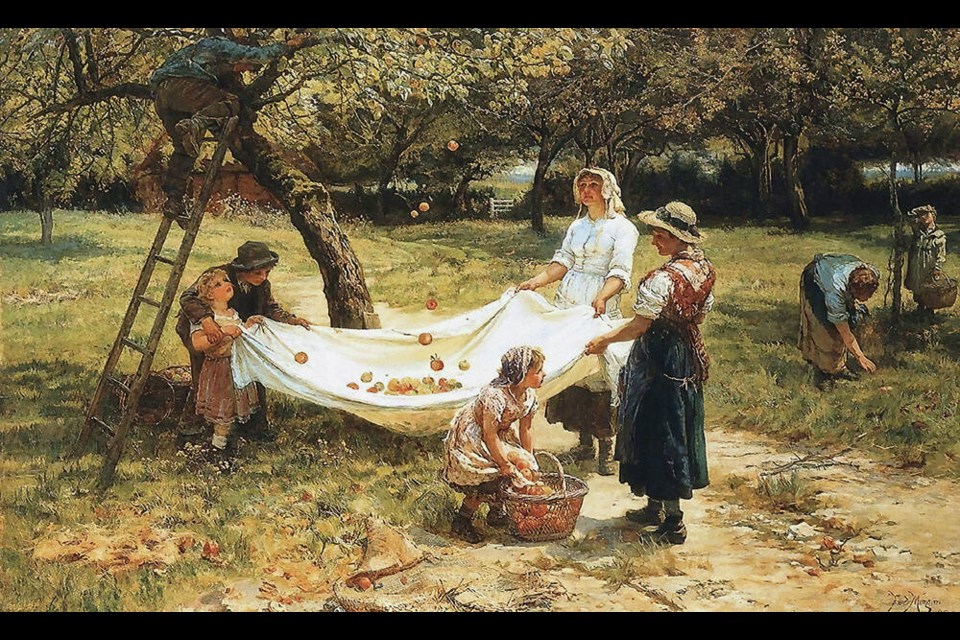A garden-themed book, especially one that incorporates a human story, is a real treat for gardeners, garden lovers, and for their friends and family at times of celebratory gift giving. Here is one with a compelling story, interspersed generously with beautiful garden-inspired art.
Taming Fruit: How Orchards have Transformed the Land, Offered Sanctuary, and Inspired Creativity, by Bernd Brunner, Greystone Books 304 pages, Hardcover, $39.95).
Inspiration for the book came from an account of an archaeological site in the northern Jordon Valley. Remains uncovered at the site were estimated to be an astonishing three hundred thousand years old. Stone tools were found, and organic remains that included fruits and nuts (acorns, almonds and more).
Long before Homo sapiens arrived out of Africa, earlier humans, animals, birds and insects were gathering food from trees and spreading the seeds around, creating continually expanding sources of food.
A preference for the best-tasting fruits, berries and nuts lead to a sort of natural selection as these preferred items would be consumed, and spread as seeds were dispersed, in the greatest numbers.
At some point in human history, seeds began to be gathered for planting closer to dwellings. These first “orchards” evolved over millennia, together with the humans associated with them, as plants with the most delicious fruits were selected for expanded plantings.
The story of these fruit gardens, and the people who managed and took pleasure in them, follows as the book presents colourful tours of date palm groves in the ancient Middle East, Egyptian gardens with grapes, figs, dates and pomegranates, and the oldest surviving orchards in Morocco.
“Orchards Unbound” delves into fruit gardening, past and present, in the tropics. In the island nation of Sri Lanka (formerly Ceylon), a traditional type of agriculture “takes the form of gewattas: gardens of miscellaneous fruit trees, herbs, and vegetables.”
The highly practical arrangement of small dwellings surrounded by fruiting trees and other food plants illustrates a beneficial harmony between human and plant life in these forest-like gardens.
Modest homes with “subsistence gardens” lush with a cooking banana called matoke, papaya, beans and ground nuts (peanuts) were common in Uganda when I lived and taught school there. The school provided students with a steamed matoke with peanut sauce lunch.
“Moving North” follows fruit tree cultivation previously found in southern regions becoming common in the British Isles by the thirteenth century, with the royal gardens often leading the way in innovative adaptation to the climate, such as greenhouses and hothouses for pineapples and grapes, and walled gardens.
The concluding chapter admits that the long history of humans carefully nurturing an evolving cultivation of fruiting plants has come to this: Most of the fruit sold today “comes from vast plantations that operate more or less like factories, with the goal of producing fruit of consistent size and flavor that stays fresh as long as possible.”
Thousands of varieties have disappeared, along with once-ubiquitous family owned orchards. The loss of genetic diversity has prompted action. The British National Fruit Collection is home to dizzying numbers of fruit and nut trees being preserved. Dedicated growers are tending old, beloved varieties in orchards of modest size. Many use organic principles, resulting in optimally aromatic, flavourful and nutritious fruit on vitally healthy trees.
The author mentions another current movement of note: the ongoing establishment of community and urban orchards and gardens, bringing food closer to where people live — which brings us right back to where this story begins.
Abkhazi Garden seasonal news. Beginning today, Abkhazi Garden, 1964 Fairfield Rd. in Victoria, is selling holiday wreaths, swags, and table toppers. The sales will continue until Dec. 24. The garden teahouse and gift shop are open Wednesday to Sunday from 11 a.m. to 4 p.m., with the last entrance at 3:30. As well as afternoon teas, the teahouse is now offering a Festive Christmas High Tea. Reservations are recommended. abkhaziteahouse.com. 778-265-6466.
Learning about plants. The Horticulture Centre of the Pacific, 505 Quayle Rd. in Saanich, is offering the next class in the Plant Identification and Culture course on Saturday, Dec. 4, 1 to 4 p.m. Jane Tice will introduce 25 new plants with their descriptions, cultural requirements, general maintenance and landscape uses. This is an ongoing, monthly class. Members $35, others $45. For details and online registration go to hcp.ca/events. Register online or by phone: 250-479-6162.



